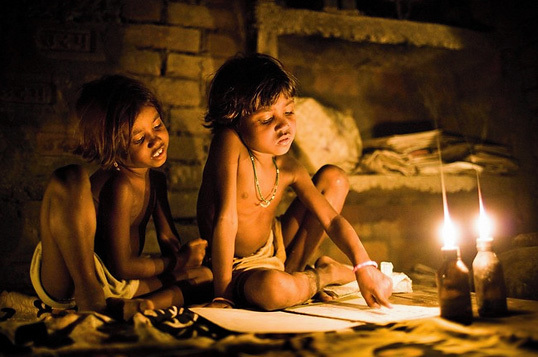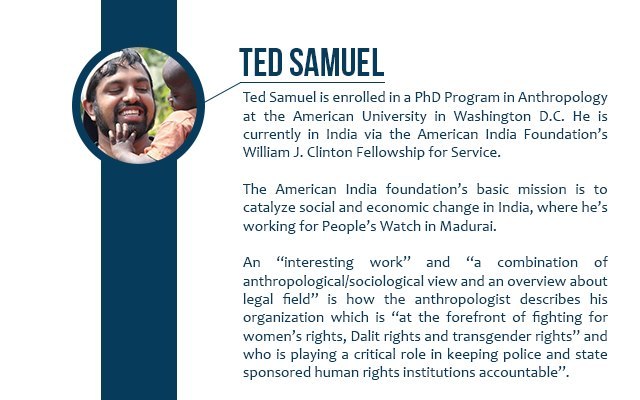
Indian Dalits - Being Untouchable Preview. Photo -- Marcus Perkins
November 7th, 2012, approximately 2.500 Vannyars, members of a dominant caste in India, attacked several villages in Tamil Nadu. The anger invaded the community further to the engagement of a girl Vannyar having married a Dalit boy. The father of the girl had apparently been completely tolerant concerning their union, but would have committed suicide a few hours later by shame.
Everything was destroyed in a few hours. Houses, jewels, rupees, and all the properties of the “untouchables” have been burnt. The villagers gave up their properties and ran away, with no casualties, by fleeing the village in flame and the violent procession which would have cost them their life.
The losses are about more than 60 000 000 rupees. “The reserves of a whole generation were demolished, Dalits were stolen, you cannot imagine to what extent my heart squeezed up and how much I cried with people of these villages to whom we took everything… I stayed two days with them, I was there as a relief and I promised to make everything to help them, I sent a petition to the government and organized some demonstrations so that the truth on this terrible action can appear in the media and so it can lead helping Dalits which undergo too many cruelties" explained Arul.
This crime organized by the community Vannyar on their colonies did not only start by the suicide of the girl’s father. Indeed, everything proves that this attack had been planned for a long time. Political action, inspiration of some parties which want to get back to a popularity rating, everything was methodically calculated.
Nevertheless, Dalits have further to this massacre begun to stand up in the name of their rights. They begin to speak more easily about the atrocities they have suffered. “The fact that they are conscious collectively of the injustices will allow them to forge ahead. People seemed ready to talk about what happened and what struggles they’ve had since. But I am not sure how to rehabilitate them. Recovery will take time, but I hope they receive the compensation that they are legally entitled to", dare hoping Ted Samuel.
Everything was destroyed in a few hours. Houses, jewels, rupees, and all the properties of the “untouchables” have been burnt. The villagers gave up their properties and ran away, with no casualties, by fleeing the village in flame and the violent procession which would have cost them their life.
The losses are about more than 60 000 000 rupees. “The reserves of a whole generation were demolished, Dalits were stolen, you cannot imagine to what extent my heart squeezed up and how much I cried with people of these villages to whom we took everything… I stayed two days with them, I was there as a relief and I promised to make everything to help them, I sent a petition to the government and organized some demonstrations so that the truth on this terrible action can appear in the media and so it can lead helping Dalits which undergo too many cruelties" explained Arul.
This crime organized by the community Vannyar on their colonies did not only start by the suicide of the girl’s father. Indeed, everything proves that this attack had been planned for a long time. Political action, inspiration of some parties which want to get back to a popularity rating, everything was methodically calculated.
Nevertheless, Dalits have further to this massacre begun to stand up in the name of their rights. They begin to speak more easily about the atrocities they have suffered. “The fact that they are conscious collectively of the injustices will allow them to forge ahead. People seemed ready to talk about what happened and what struggles they’ve had since. But I am not sure how to rehabilitate them. Recovery will take time, but I hope they receive the compensation that they are legally entitled to", dare hoping Ted Samuel.
When images illustrate pain
People are still talking about November 7th, 2012. The political event led to a whole process of violence against Dalits. In December, Ted Samuel, PhD student in anthropology at the American University of Washington D.C. and currently enrolled in a fellowship with People’s Watch, went on the spot to help the victims of these atrocities. He gave his testimony to Le Journal International to tell us his idea of the modesty of the image, after taking photos witnessing the damage in one of the villages.

Why did the Vannyars target these villages in the Tamil Nadu just because of a wedding? How can a union create such anger?
It has not been confirmed whether the father had actually been murdered, but according to many people – even our colleagues at People’s Watch – the incidents surrounding his death were awfully suspicious. As for the wedding itself… Such unions often do cause anger. But I don’t think that the reason for this attack was just because of the wedding. I think it had more to do with the fact that Dalits had begun improving their socio-economic standing and the Vannyars – traditionally the dominant caste in the area – were threatened by this. Anger over an intercaste marriage could very well have been a mere facade for deeper seated tensions.
Why don’t you consider they were “spontaneous” riots?
Initial reports said it was spontaneous. But the reasons I listed in the blog make me believe that it wasn’t. Several social workers and scholars concur with this. The biggest reason, I think, to believe this was a planned attack, lies in the systematic nature of it. How would people happen to have hundreds of petrol bombs if they hadn’t planned on using them to destroy something? Why did they target signs of material wealth rather than obliterating the entire village? It didn’t necessarily match up with notions of a mob mentality.
You got involved with People’s Watch one month after the incident. How was your preparation to mediate in this kind of “hard” field?
People’s Watch actually intervened right away to do a fact finding mission. I was not present for this, as I was out of town. But I took the reports they gathered and reports from the news to draft a summary of the incident. I believe they used this summary to seek funding for this relief mission. It took one month to secure funds and all the supplies needed for this.
Why is it necessary to take pictures of this “horror show”?
The pictures I refer to, taking shots of people as they received their goods, were not actually shown in this blog. I only shared three of many many pictures that I took. To be honest, the pictures that I took for the relief effort were very mechanical. I was assigned this job by my colleagues at people’s watch. Also the fact that I had my own camera made this possible. I only did this in one of the villages and I do not know how they took care of this elsewhere. However, the pictures you saw on the blog had nothing to do with my formal role in the relief effort. This is when the women took me around. They had seen me with the camera and were insistent that I take the pictures. The filming happened a bit later. As I said, I hadn’t planned on doing any of this before that day.
In this field, I suppose that “ethical” feeling could be interrogated. Did you think at first that it was inappropriate to film or take pictures of these poor people?
Before going, I didn’t know what to expect really. I thought my role would be a simple one. But since they didn’t start distributing goods until later in the day, I had time to take a few shots of people unloading the lorries. And it went on from there. In the end, I only took pictures of what people encouraged me to film.
Some people stuck at you because they wanted you to take pictures of them to let people all around the world know about their pain, what was your reaction?
A woman has shown me one bag with around 20000 rupees who have disappeared in a smoke. It was not all her money. It was money for the chith, or a local borrowing practice where people pool their resources together. My reaction to this was kind of stunned but at the same time kind of numb. At some points I had to emotionally distance myself from what was going on and just do as they asked. In this case, you don’t interrogate the ethic. You live the moment and that’s all. “In one particular room, which had clearly been bombed, I asked one of the women: “Record-pannu mudiyamaa?” (“Can I record?”). I couldn’t possibly fit the entire room into one visual shot and do it any justice. From the floors to the ceiling… It was destroyed. So I wanted to film a panning type shot. It is in the film I posted.”
It has not been confirmed whether the father had actually been murdered, but according to many people – even our colleagues at People’s Watch – the incidents surrounding his death were awfully suspicious. As for the wedding itself… Such unions often do cause anger. But I don’t think that the reason for this attack was just because of the wedding. I think it had more to do with the fact that Dalits had begun improving their socio-economic standing and the Vannyars – traditionally the dominant caste in the area – were threatened by this. Anger over an intercaste marriage could very well have been a mere facade for deeper seated tensions.
Why don’t you consider they were “spontaneous” riots?
Initial reports said it was spontaneous. But the reasons I listed in the blog make me believe that it wasn’t. Several social workers and scholars concur with this. The biggest reason, I think, to believe this was a planned attack, lies in the systematic nature of it. How would people happen to have hundreds of petrol bombs if they hadn’t planned on using them to destroy something? Why did they target signs of material wealth rather than obliterating the entire village? It didn’t necessarily match up with notions of a mob mentality.
You got involved with People’s Watch one month after the incident. How was your preparation to mediate in this kind of “hard” field?
People’s Watch actually intervened right away to do a fact finding mission. I was not present for this, as I was out of town. But I took the reports they gathered and reports from the news to draft a summary of the incident. I believe they used this summary to seek funding for this relief mission. It took one month to secure funds and all the supplies needed for this.
Why is it necessary to take pictures of this “horror show”?
The pictures I refer to, taking shots of people as they received their goods, were not actually shown in this blog. I only shared three of many many pictures that I took. To be honest, the pictures that I took for the relief effort were very mechanical. I was assigned this job by my colleagues at people’s watch. Also the fact that I had my own camera made this possible. I only did this in one of the villages and I do not know how they took care of this elsewhere. However, the pictures you saw on the blog had nothing to do with my formal role in the relief effort. This is when the women took me around. They had seen me with the camera and were insistent that I take the pictures. The filming happened a bit later. As I said, I hadn’t planned on doing any of this before that day.
In this field, I suppose that “ethical” feeling could be interrogated. Did you think at first that it was inappropriate to film or take pictures of these poor people?
Before going, I didn’t know what to expect really. I thought my role would be a simple one. But since they didn’t start distributing goods until later in the day, I had time to take a few shots of people unloading the lorries. And it went on from there. In the end, I only took pictures of what people encouraged me to film.
Some people stuck at you because they wanted you to take pictures of them to let people all around the world know about their pain, what was your reaction?
A woman has shown me one bag with around 20000 rupees who have disappeared in a smoke. It was not all her money. It was money for the chith, or a local borrowing practice where people pool their resources together. My reaction to this was kind of stunned but at the same time kind of numb. At some points I had to emotionally distance myself from what was going on and just do as they asked. In this case, you don’t interrogate the ethic. You live the moment and that’s all. “In one particular room, which had clearly been bombed, I asked one of the women: “Record-pannu mudiyamaa?” (“Can I record?”). I couldn’t possibly fit the entire room into one visual shot and do it any justice. From the floors to the ceiling… It was destroyed. So I wanted to film a panning type shot. It is in the film I posted.”





























